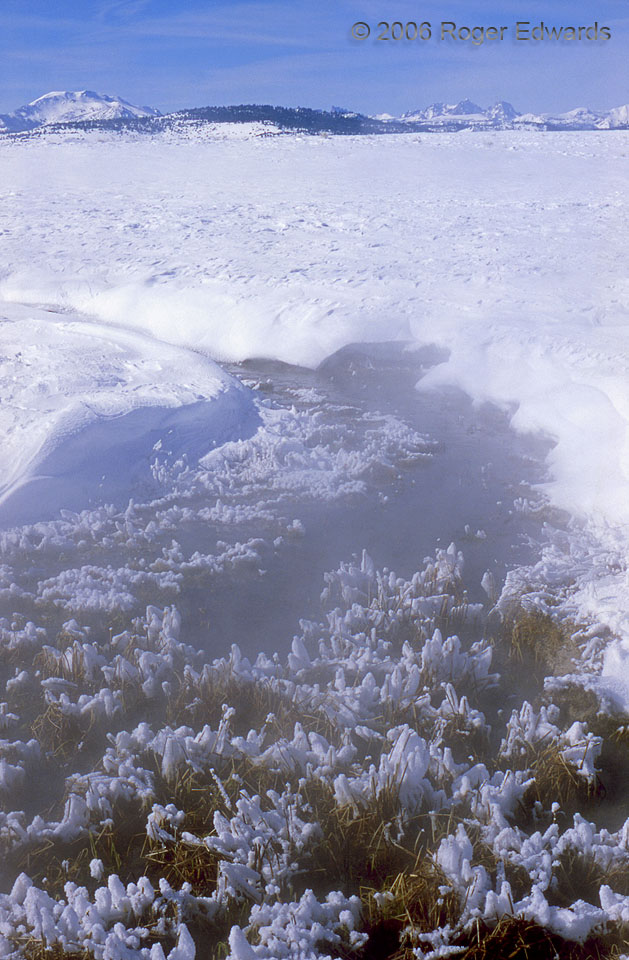 Frigid wintertime air drifts over the geothermally heated stream sensibly named Hot Creek, drawing steam fog into the air, and depositing hoarfrost on the grasses above the waterline. The whole area from my position to the mountains in the background, and for several miles behind me, form the surface floor of the Long Valley Caldera, the other major, active volcanic caldera in the U.S. besides Yellowstone. Like its more famous counterpart, Long Valley has had several incomprehensibly immense eruptions in the past few million years, one of which lofted ash as far east as Kansas. Steam holes (fumaroles), gas cracks (fissures) and minor earthquakes tell us the red-hot magma still lurks not too far below ground, awaiting enough pressure buildup for whenever the next big eruption may throttle up. To the distant left is Mammoth Mountain, a volcano on the SW side of the same caldera that holds a big ski resort. Around 1,300 tons of carbon dioxide per day spew out of fissures and fumaroles there, and its occasionally severe outgassings have killed trees and people. About 2-1/2 months after I shot this slide, three members of the Mammoth ski patrol died of suffocation when they got caught in a CO2-filled collapse of a hidden snow cave. Fortunately for me, no major CO2 outbursts are known to have happened around Hot Creek, and I could concentrate on enjoying the warm water and its marvelous effects.
12 ENE Mammoth Lakes CA (20 Jan 6) Looking W
37.6659, -118.781
Frigid wintertime air drifts over the geothermally heated stream sensibly named Hot Creek, drawing steam fog into the air, and depositing hoarfrost on the grasses above the waterline. The whole area from my position to the mountains in the background, and for several miles behind me, form the surface floor of the Long Valley Caldera, the other major, active volcanic caldera in the U.S. besides Yellowstone. Like its more famous counterpart, Long Valley has had several incomprehensibly immense eruptions in the past few million years, one of which lofted ash as far east as Kansas. Steam holes (fumaroles), gas cracks (fissures) and minor earthquakes tell us the red-hot magma still lurks not too far below ground, awaiting enough pressure buildup for whenever the next big eruption may throttle up. To the distant left is Mammoth Mountain, a volcano on the SW side of the same caldera that holds a big ski resort. Around 1,300 tons of carbon dioxide per day spew out of fissures and fumaroles there, and its occasionally severe outgassings have killed trees and people. About 2-1/2 months after I shot this slide, three members of the Mammoth ski patrol died of suffocation when they got caught in a CO2-filled collapse of a hidden snow cave. Fortunately for me, no major CO2 outbursts are known to have happened around Hot Creek, and I could concentrate on enjoying the warm water and its marvelous effects.
12 ENE Mammoth Lakes CA (20 Jan 6) Looking W
37.6659, -118.781Steam Fog at Hot Creek
 Frigid wintertime air drifts over the geothermally heated stream sensibly named Hot Creek, drawing steam fog into the air, and depositing hoarfrost on the grasses above the waterline. The whole area from my position to the mountains in the background, and for several miles behind me, form the surface floor of the Long Valley Caldera, the other major, active volcanic caldera in the U.S. besides Yellowstone. Like its more famous counterpart, Long Valley has had several incomprehensibly immense eruptions in the past few million years, one of which lofted ash as far east as Kansas. Steam holes (fumaroles), gas cracks (fissures) and minor earthquakes tell us the red-hot magma still lurks not too far below ground, awaiting enough pressure buildup for whenever the next big eruption may throttle up. To the distant left is Mammoth Mountain, a volcano on the SW side of the same caldera that holds a big ski resort. Around 1,300 tons of carbon dioxide per day spew out of fissures and fumaroles there, and its occasionally severe outgassings have killed trees and people. About 2-1/2 months after I shot this slide, three members of the Mammoth ski patrol died of suffocation when they got caught in a CO2-filled collapse of a hidden snow cave. Fortunately for me, no major CO2 outbursts are known to have happened around Hot Creek, and I could concentrate on enjoying the warm water and its marvelous effects.
12 ENE Mammoth Lakes CA (20 Jan 6) Looking W
37.6659, -118.781
Frigid wintertime air drifts over the geothermally heated stream sensibly named Hot Creek, drawing steam fog into the air, and depositing hoarfrost on the grasses above the waterline. The whole area from my position to the mountains in the background, and for several miles behind me, form the surface floor of the Long Valley Caldera, the other major, active volcanic caldera in the U.S. besides Yellowstone. Like its more famous counterpart, Long Valley has had several incomprehensibly immense eruptions in the past few million years, one of which lofted ash as far east as Kansas. Steam holes (fumaroles), gas cracks (fissures) and minor earthquakes tell us the red-hot magma still lurks not too far below ground, awaiting enough pressure buildup for whenever the next big eruption may throttle up. To the distant left is Mammoth Mountain, a volcano on the SW side of the same caldera that holds a big ski resort. Around 1,300 tons of carbon dioxide per day spew out of fissures and fumaroles there, and its occasionally severe outgassings have killed trees and people. About 2-1/2 months after I shot this slide, three members of the Mammoth ski patrol died of suffocation when they got caught in a CO2-filled collapse of a hidden snow cave. Fortunately for me, no major CO2 outbursts are known to have happened around Hot Creek, and I could concentrate on enjoying the warm water and its marvelous effects.
12 ENE Mammoth Lakes CA (20 Jan 6) Looking W
37.6659, -118.781